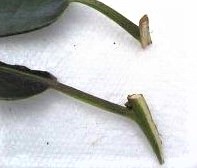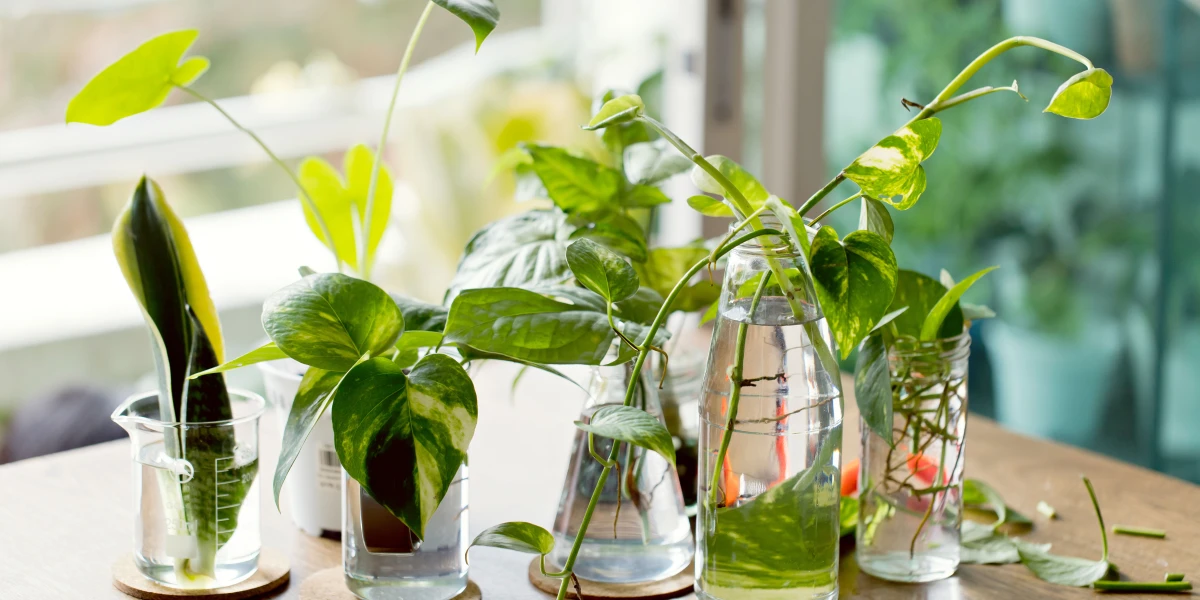Get Many New Plants from Your Houseplants
Many houseplants are grown by nurseries through vegetative (asexual) reproduction rather than from seeds. This is because the plants grown will be clones of the parent plant and will be just the same as the parent; cuttings can be chosen from the best most vigorous plants. Whereas plants from sexual reproduction and production of seeds will vary and the outcomes will not be known until the plant has grown.
Some plants will be grown from tissue culture which is where the new plants are grown on agar culture plates from very small pieces of the parent plant tissue. This is a specialised method used by commercial growers to get many cloned plants from a few individuals.
For home growers taking more substantial pieces of the parent plant, known as a cutting, is the easier way to produce new plants from your existing houseplants.
Here are the easy steps to propagating new houseplants from your existing plants:
What You Will Need
- Healthy, vigorous houseplants are suitable for propagation.
- Gro-Sure Houseplant Potting Compost or a mix of peat/bark compost with sand and perlite.
- A rooting hormone dip product or use natural alternatives such as apple cider vinegar or cinnamon
- Plant labels and marker pen.
- Small cane or old pencil to create a hole in potting mix for planting cuttings.
- Clean, sterilised, sharp, fine, cutting scissors or snipping secateurs.
- Small (~6 cm diameter) plastic or biodegradable jiffy pots.
- A large tray to do your work in.
- Propagator and mat heater.
Prepare Your Pots
- In the tray (to catch spilled media) fill the pots with your Houseplant Potting Compost or mix. Fill to the top of the pot and a little above because when watered the potting mix will compress.
- Water the pots well to ensure all the potting mix is damp and leave them to drain.
Tip Cuttings
This is the simplest form of cutting and is suitable for most multi-stemmed houseplants (e.g. Ficus, Hoya). Tip cuttings include the terminal bud which is the growing tip of a stem.
- Cut 10-15 cm from the tip of the main stem or side branch. Cut just below where the leaf and stem meet (node) and cut at an angle.
- Remove the lower leaves from the cutting and any flowers.
- Dust cut ends with rooting hormone powder.
- Then plant in moist rooting medium by pushing the cane or pencil into the mix to create a hole and then placing the cutting into the hole and gently firming the compost around the stem. Keep all leaves above the soil. Two cuttings can be planted in each pot for a bushier outcome but look at where they came from the parent and plant them so that they will tend to grow away from each other (left and right).
- Label your plants with the name of the plant and the date the cuttings were taken.
- Once you have cut and potted up all your cuttings you will need to provide them with conditions that will encourage rooting. Provide indirect light and bottom heat. If you have a propagator and heater this will give ideal conditions.
- When the cuttings resist being pulled from the potting mix, they are taking root. Let them grow on for another 1-2 weeks until they are firmly rooted in the mix then dig up gently, check root growth, and pot up into a larger pot (not more than 10 cm diameter). Or if jiffy pots have been used plant the whole jiffy pot in the new pot. See Re-potting Your Houseplants.
Heel Cuttings
Heel cuttings are side shoots taken off of woody stems that are at least 2 years old. The cuttings contain a piece of the main wood stem at the base. Heel cuttings are often better for propagating difficult to root plants.
- Gently pull a suitable side shoot off of the main stem, which usually leaves a small piece of the main stem attached to the base of the shoot (heel). Or cut the shoot and a small section of the stem off with sharp, clean snipping secateurs. Then peel off the stem section leaving the heel.

- These can then be treated and planted as 2-7 above.
These are great ways to produce new houseplants for your own house or as gifts to friends and family.
For ongoing care of your cuttings and houseplants see "CPR for Your Houseplants".


